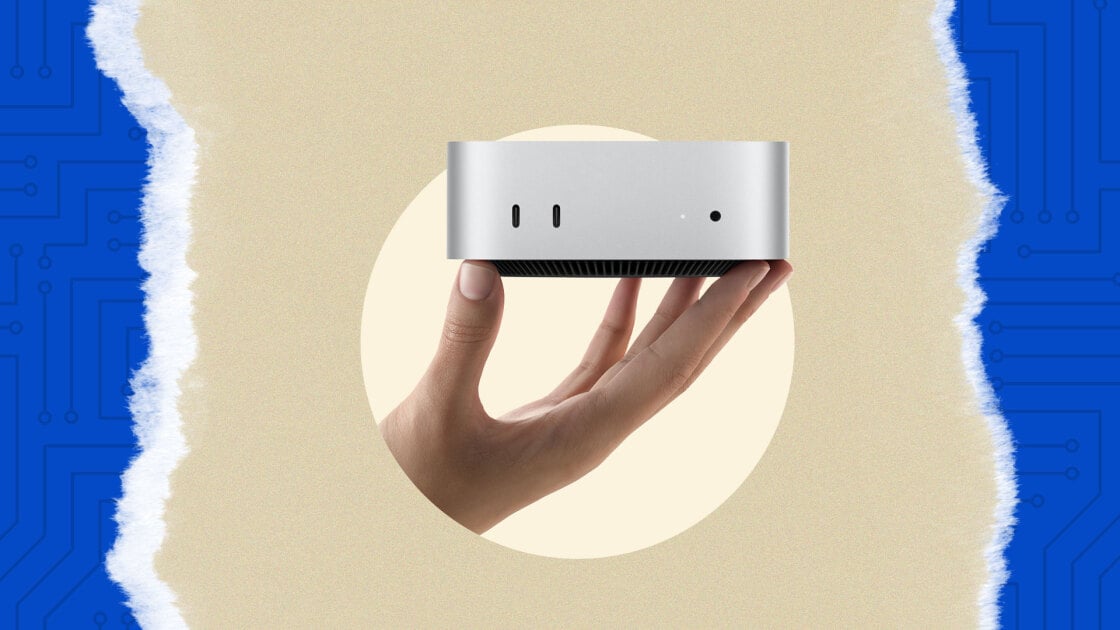After being overlooked in the third-generation M-series computers, the Mac mini is back to provide the most economical entry point to Apple’s M4 line of chips. Keeping its starting price at $599, Apple also boosts its starting configuration to 16GB of unified storage as a base.
This has two effects: First, it finally dispels any negativity about Apple’s use of 8GB of memory in starting configurations without costing anyone extra money. Second, paired with the M4 processor, it enables the ideal version of Apple Intelligence AI tools to be released in the macOS Sequoia 15.1 update. (AI tools like this are known to be memory hungry on all processor platforms.)
Apple is now taking pre-orders for the Mac mini ahead of a November 8 launch.
Macro size varies in and out
In a surprise move, Apple updated the Mac mini design to make room for more useful connections, leading to a more Mac Studio-like appearance. Measuring 5 inches on each side horizontally and 2 inches tall instead of 1.4 by 7.7 by 7.7 inches (HWD) as before, the new Mac mini gains two USB-C 3.1 10 Gbps ports and a audio jack on the front side.
On the back, the less ball-like desktop features three Thunderbolt 4 ports, an Ethernet jack, and an HDMI port. That’s unfortunate news for anyone still clinging to USB-A accessories, as those ports have been put out to pasture.
While in some ways it’s a step up in ports, it’s by no means lacking in display support—the new Mac mini powers up to three 6K-resolution displays from its Thunderbolt 4 array.

USB-A goes MIA with the new Mac mini. (Credit: René Ramos; Apple)
Apple is also touting the fact that this is the first completely carbon-neutral Mac product. It uses less aluminum in its chassis design and more fiber-based packaging than ever before.
The 3-nanometer, fan-cooled M4 chip inside is an eight-core CPU paired with an eight-core GPU (with an optional 10-core part) and a 16-core Neural Engine coprocessor to handle artificial intelligence tasks in board. That’s paired with that double 16GB of storage and a 256GB SSD, starting at $599. The Mac mini supports up to 64 GB of memory and up to 8 TB of SSD space.
Apple says this model is 1.6 times faster than the M2 Mac mini in the Affinity Photo app and 1.4 times faster than its predecessor when running World of Warcraft. Overall, Apple says the M4 processor houses the fastest CPU core of any computer chip to date, and the company claims 1.8x faster CPU performance and 2.2x faster GPU speed over the M1 Mac mini .
Recommended by our Editors
Introducing the Apple M4 Pro processor
The newest Mac mini is the debut stage for the first advanced M4 processor, the M4 Pro, a higher-end configuration option. This is a 14-core CPU with an up to 20-core GPU and the same 16-core Neural Engine as the base chip. Apple’s new GPU also specifically doubles ray tracing performance for better real-time lighting detail in 3D games and modeling applications.
Overall, Apple says this version of the Mac mini has been designed to be twice as fast as the previous model with the M2 Pro. The M4 Pro also unlocks 120Gbps Thunderbolt 5 ports for the Mac mini, which is the absolute latest in the connectivity standard.

The new Mac mini is much more similar to Mac Studio than before. (Credit: Apple)
Specifically regarding the M4 Pro, Apple has boasted about its expanded memory bandwidth, now 273 GB/s. According to Apple, this increased bandwidth improves performance with AI workloads and is twice that of any competing AI computer.
Instead of just a basic refresh of the internal silicon, Apple has improved almost everything about the Mac mini with this revision, especially the initial memory configuration. That and the more convenient design represent a lot of added value for the same $599 starting price, though USB-A ports will be sorely missed. We will reserve any further judgment for our final review.
Apple fan?
Sign up for our Apple Weekly Roundup for the latest news, reviews, tips and more delivered straight to your inbox.
This newsletter may contain advertisements, deals or affiliate links. Subscribing to a newsletter indicates your consent to our Terms of Use and Privacy Policy. You can unsubscribe from newsletters at any time.
About Joe Osborne
Deputy Managing Editor, Hardware


